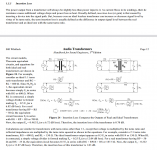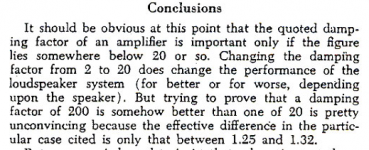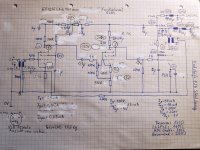I don’t think the Zobel does anything for the bass reflex peaks at the low end of the frequency range, does it? Wouldn’t you need a notch filter for that? My woofers (Western Electric 2080a) have a rather high inductance (2mH) and the Zobel is there to stop the impedance from rising at higher frequencies, especially since i am using a first order crossover.
daanve,
OK.
A 5000 Ohm primary that has no DCR, versus a primary (5000 + 500 Ohms) that has 500 Ohms DCR.
1 Volt across 5000 Ohms = 0.2 mA
1 Volt appears across the 5000 Ohms primary (that has no DCR).
The resultant power is transferred to the output (if there are no other losses).
1 Volt across 5500 Ohms = 0.18 mA
0.18 mA across 5000 Ohms = 0.909V
Where did the other 0.09V go?
0.909V + 0.09V = 0.999V
0.09V is across the 500 Ohm DCR.
0.18mA (0.09V) across the 500 Ohm DCR does not appear in the output signal power.
0.18mA (0.909 Volts) appears across the 5000 Ohm primary, and is transferred as signal power to the output (if there are no other losses).
Power = (E squared)/R
1V squared = 1
0.909V squared = 0.826.
OK, so it is only a -0.8287 dB loss with DCR, versus the power without DCR loss.
And so 10 Watts from the output tube, becomes 8.26 Watts
Now, does it matter if the only DCR is in the primary, and it is 10% of the primary impedance . . . versus a primary with DCR of 5% of its impedance plus the effect of a secondary with DCR that is 5% of its secondary impedance.
The total loss either way is due to a total of 10% DCR.
Right?
I need to stop doing those sleepy time calculations.
All of us make mistakes, I just make more of them.
And I love slop jar slide rule calculations. Early rocket motors did not have precision thrust and angular direction. That was a real good reason to have
mid-course corrections on the way to the moon (it is not fun to shoot by the moon, and not fun to plow directly into it either).
This explains it, using the appropriate formulas:
Attachments
A little OT but it does relate to the OPT..... Where does the damping factor matter most? Is it just the bass response that needs damping? If so, the critical mids and highs might not be affected and the system might still sound good. Especially where the speaker is a bookshelf 2-way with limited deep bass.
Andy,
Read Brinkman's very useful link (#436).
On Roger Russells (RIP) website there is an article by George Augspurger that shows that whatever the damping factor is at the amp output, at the voice coil, where it counts, it will never be larger than 1.33.
Yes, but Augspurger says that the damping factor will never be higher than 1.33.
When lower than 20 at the amp output it will be lower than 1.33, but never higher whatever the damping factor at the amp output.
When lower than 20 at the amp output it will be lower than 1.33, but never higher whatever the damping factor at the amp output.
Right, but the relevant thing here is to realize that damping factors under 20 influence basic loudspeaker behaviour like frequency and impulse response.
Too often it is overlooked that SE tube amplifiers and loudspeakers must work well as a combo.
Otherwise either the amplifier or the loudspeaker (and likely both) will not give their best.
Too often it is overlooked that SE tube amplifiers and loudspeakers must work well as a combo.
Otherwise either the amplifier or the loudspeaker (and likely both) will not give their best.
Last edited:
boli46,
You are right in your Post # 433.
I could not find any 8 Ohm Western Electric loudspeakers.
I have to admit I was wrong.
So, the other poster needs to get a pair of another manufacturer's 8 Ohm speakers,
and either wire in series to get 16 Ohms, or in parallel to get 4 Ohms.
I see many Western Electric 8 inch drivers that are for sale for more than $1,000.
The poster who has a Western Electric speaker, should sell it quickly for $500,
and then he can purchase a pair of 8 Ohm speakers.
Just another silly solution of mine.
You are right in your Post # 433.
I could not find any 8 Ohm Western Electric loudspeakers.
I have to admit I was wrong.
So, the other poster needs to get a pair of another manufacturer's 8 Ohm speakers,
and either wire in series to get 16 Ohms, or in parallel to get 4 Ohms.
I see many Western Electric 8 inch drivers that are for sale for more than $1,000.
The poster who has a Western Electric speaker, should sell it quickly for $500,
and then he can purchase a pair of 8 Ohm speakers.
Just another silly solution of mine.
For low frequencies, another influence on the impulse response of a woofer is the inductance of the output transformer secondary.
I used a Vector Network Analyzer to measure the impedance versus frequency of a single ended amplifier, with the output tube removed, and the amplifier turned off.
That varying impedance of the output transformer secondary is in parallel with the load.
That has an effect on damping factor of the amplifier when the output tube is in place, and the amp is turned on.
The impedance of a bare bones single ended output transformer secondary is interesting.
There is the secondary inductance influence on impedance at low frequencies,
And the primary winding's distributed capacitative impedance at high frequencies, which is impedance transformed downward (it reflects to a lower impedance on the secondary winding).
I used a Vector Network Analyzer to measure the impedance versus frequency of a single ended amplifier, with the output tube removed, and the amplifier turned off.
That varying impedance of the output transformer secondary is in parallel with the load.
That has an effect on damping factor of the amplifier when the output tube is in place, and the amp is turned on.
The impedance of a bare bones single ended output transformer secondary is interesting.
There is the secondary inductance influence on impedance at low frequencies,
And the primary winding's distributed capacitative impedance at high frequencies, which is impedance transformed downward (it reflects to a lower impedance on the secondary winding).
Last edited:
I've previously been rather dismissive of Lundahl's LL1664 as a SE OPT for the 300b, preferring the LL1682. This is still the case - to me ears a higher primary impedance cleans up the midrange from some of the 300b's euphonic sound.
But I'm now using the LL1664 with a pair of 6C4C outputs and the result is excellent. The 6C4C is a Soviet copy of early US biplate 2a3s and I rate it very highly - usual Svetlana quality build. So my 300bs are going back on the shelf and I'm converting my amps to 6C4C. Good to know that the LL1664 is a good option for this - it's not overpriced.
But I'm now using the LL1664 with a pair of 6C4C outputs and the result is excellent. The 6C4C is a Soviet copy of early US biplate 2a3s and I rate it very highly - usual Svetlana quality build. So my 300bs are going back on the shelf and I'm converting my amps to 6C4C. Good to know that the LL1664 is a good option for this - it's not overpriced.
The 6C4C seems to be a dual anode plate tube, like a 2A3.
Without knowing this tube in detail, I've always preferred single plate tubes like an AD1/RE604 over double plates. The price seems reasonable, but I paid not much more for my stash of F2A Siemens, a 10K hour pentode with the same output rating like a 300B.
Don't know if the soviet tube is able for such long distances, but they have produced excellent military equipment.
In the end, a well engineered tube amp design to MIL standards and heavily oversized will sound good with nearly any output tube, doesn't matter if its a 300B.
Without knowing this tube in detail, I've always preferred single plate tubes like an AD1/RE604 over double plates. The price seems reasonable, but I paid not much more for my stash of F2A Siemens, a 10K hour pentode with the same output rating like a 300B.
Don't know if the soviet tube is able for such long distances, but they have produced excellent military equipment.
In the end, a well engineered tube amp design to MIL standards and heavily oversized will sound good with nearly any output tube, doesn't matter if its a 300B.
The 6C4C seems to be a dual anode plate tube, like a 2A3.
Without knowing this tube in detail, I've always preferred single plate tubes like an AD1/RE604 over double plates. The price seems reasonable, but I paid not much more for my stash of F2A Siemens, a 10K hour pentode with the same output rating like a 300B.
Don't know if the soviet tube is able for such long distances, but they have produced excellent military equipment.
In the end, a well engineered tube amp design to MIL standards and heavily oversized will sound good with nearly any output tube, doesn't matter if its a 300B.
do you have a schematic for your F2A amp? I have a pair and I haven't used them yet.
The 6C4C seems to be a dual anode plate tube, like a 2A3.
Without knowing this tube in detail, I've always preferred single plate tubes like an AD1/RE604 over double plates. The price seems reasonable, but I paid not much more for my stash of F2A Siemens, a 10K hour pentode with the same output rating like a 300B.
How long ago did you buy your F2a. Ebay today F2a 500$ a pair vs 6C4C 80$ a pair. 😀😀
But if the the F2a in triode, is a linear as the schematic suggest. I might understand the price. Especially when you look at how easy it is to drive.🙂
Here you go. But this is one is hyper sensitive at the input...just saying.do you have a schematic for your F2A amp? I have a pair and I haven't used them yet.
Bought F2A five years ago, price was reasonable😀
Attachments
Hi Andy,Bud Purvine recommended to me in an email that transformers sounded better open frame "unless you wanted them to sound like the Ringland Brothers". That may be overstating the case, but there's another similar opinion.
When I use the Hammond 126C I take the end bells off it.
Have you compared them with/without endbells?
RC
I was just offering up Bud Purvine's opinions as a very experienced transformer winder. By all means try with and without if you want to test the hypothesis.I guess all those potted OPTs must be junk.
- Home
- Amplifiers
- Tubes / Valves
- Best 300B SE OPT?


